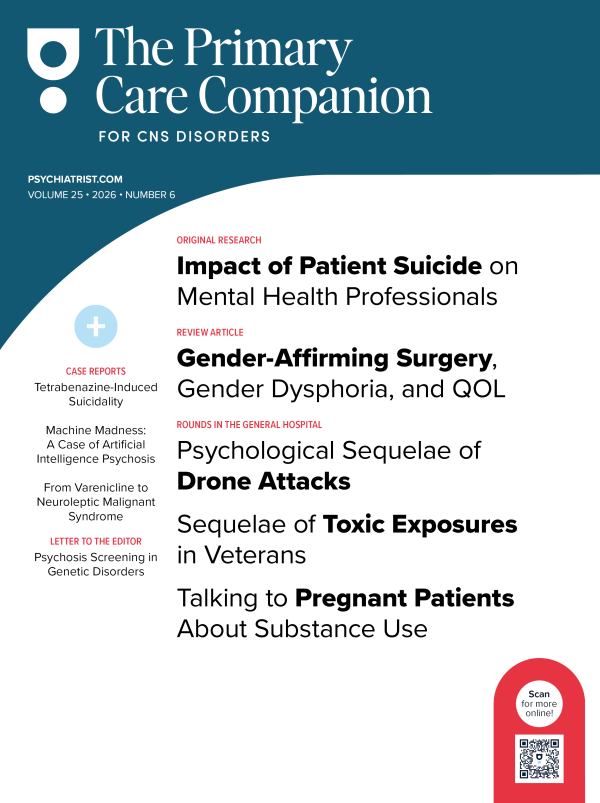Because this piece does not have an abstract, we have provided for your benefit the first 3 sentences of the full text.
To the Editor: Routine urine drug screening in research trials is an underappreciated risk for trial participants. We present a case of lamotrigine cross-reactivity with phencyclidine (PCP) in a clinical trial in which a positive test result was an exclusion criterion and discuss implications.
Case report. Ms A is a 44-year-old woman with well-characterized schizophrenia who agreed to participate in a clinical trial for treatment-resistant psychotic symptoms.
Lamotrigine Cross-Reactivity With Phencyclidine in Rapid Urine Toxicology in a Research Study
To the Editor: Routine urine drug screening in research trials is an underappreciated risk for trial participants. We present a case of lamotrigine cross-reactivity with phencyclidine (PCP) in a clinical trial in which a positive test result was an exclusion criterion and discuss implications.
Case report. Ms A is a 44-year-old woman with well-characterized schizophrenia who agreed to participate in a clinical trial for treatment-resistant psychotic symptoms. She was on a stable dose of lamotrigine 200 mg/d and perphenazine 4 mg/d. She had been treated clinically at the research site for several years and had no history of substance use.
As part of protocol-mandated screening, the participant underwent a rapid urine drug immunoassay (the 6-panel iCup Urine Drug Test, Redwood Toxicology Laboratory, Santa Rosa, California) that came back positive for PCP. The patient denied drug use, showed no symptoms of intoxication other than her chronic psychosis, and did not fit the profile of a PCP user. PCP use is also currently rather uncommon in our community. We repeated the rapid urine drug immunoassay along with a concurrent, specific urine test using mass spectrometry. The rapid urinalysis was again positive, yet the laboratory testing was negative for PCP use, confirming the principal investigator’s suspicion of a false-positive test result.
Cross-reactivity between lamotrigine and PCP in rapid urine drug screens has been previously reported,1 and rapid urine toxicology screens have been shown to have low specificity, particularly with regard to PCP.2 While a review of the literature did not provide an explanatory mechanism for this cross-reactivity, this phenomenon has been documented in clinical settings. An analysis2 of a hospitalized cohort found that only 1 in 40 patients who tested positive for PCP admitted to past PCP use. In this cohort, the majority of false positives were attributed to quetiapine and venlafaxine, although lamotrigine was also listed as a suspected cross-reagent.2 While those results speak to the challenges of using rapid drug testing to accurately characterize patients receiving direct patient care, the risk posed to people in research settings deserves consideration as well.
Indiscriminate screening using rapid urine drug immunoassay is often used to screen participants in research, just like it is used as part of the hiring process for new employees. However, screening in a population with low prior probability greatly increases the risk for false-positive test results. People may be wrongfully barred from participation in research and experience distress for being falsely accused of drug use and not being believed. Moreover, the burden of proof for sobriety now falls on the research subject—an impossible task, as one can never fully prove a negative. Even the tests themselves do not always provide adequate resources for explaining false positives (in this case, the test’s package insert made no mention of the risk of cross-reactivity with lamotrigine, although on follow-up, the manufacturer disclosed that it is listed as a possible cross-reagent on an internal list). This risk of a false-positive result may ultimately dissuade patients from any trial participation in the future, an outcome that cannot be in the interest of society. We present this case to argue for careful consideration with regard to managing positive urine drug test results in clinical trials before a trial begins. Possible safeguards for clinical trial participants include allowing for clinical judgment (including that a result is most likely false positive) rather than categorical exclusion and using tests with higher specificities to test the substance in question.
References
1. Geraci MJ, Peele J, McCoy SL, et al. Phencyclidine false positive induced by lamotrigine (Lamictal) on a rapid urine toxicology screen. Int J Emerg Med. 2010;3(4):327-331. PubMed CrossRef
2. Fischer M, Unterecker S, Pfuhlmann B, et al. Methodological problems arising from false-positive drug screenings. Pharmacopsychiatry. 2014;47(06):A5_2. CrossRef
aSchizophrenia Clinical and Research Program, Massachusetts General Hospital, Boston, Massachusetts
Potential conflicts of interest: None.
Funding/support: This case report describes an event that occurred during a clinical trial funded by the Stanley Medical Research Institute.
Role of the sponsor: The sponsor had no role in the preparation, review, or approval of this report.
Patient consent: The patient provided permission to present this case, which has been deidentified to protect anonymity.
Published online: July 26, 2018.
Prim Care Companion CNS Disord 2018;20(4):17l02192
To cite: McCain CF, Namey LB, Freudenreich O. Lamotrigine cross-reactivity with phencyclidine in rapid urine toxicology in a research study. Prim Care Companion CNS Disord. 2018;20(4):17l02192.
To share: https://doi.org/10.4088/PCC.17l02192
© Copyright 2018 Physicians Postgraduate Press, Inc.
Please sign in or purchase this PDF for $40.00.


